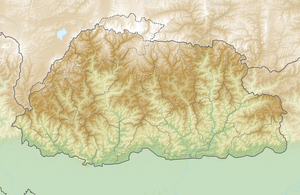Drukyel Dzong
| Drukyel Dzong | ||
|---|---|---|
|
The ruins of the Drukyel Dzong. |
||
| Creation time : | 1647 | |
| Castle type : | Dzong (monastery castle) | |
| Conservation status: | ruin | |
| Geographical location | 27 ° 31 '52 " N , 89 ° 19' 21" E | |
|
|
||
The Drukyel-Dzong , also written Drukgyel , is a former Buddhist monastery fortress in the Paro district in the Kingdom of Bhutan , about 18 kilometers from Paro . The village of Tsento is at your feet .
The monastery fortress was probably built by Tenzin Drukdra in 1647 at the behest of Shabdrung Ngawang Namgyel . The name of the fortress recalls the victorious defense against the invasion from Tibet three years earlier. Drukyel-Dzong means fortress of the victorious Drukpa .
The monastery fortress is in a dominant position on a rocky plateau in the upper Paro valley . It seals off the Paro Valley and thus protected it from intruders from the north. Unlike other dzongs that were built by Shabdrung Ngawang Namgyel and his successors, the Drukyel Dzong was used exclusively for national defense against external threats and had no administrative or religious functions. At the time, the dzong housed the best arsenal in the country.
The facility has been falling into disrepair since a fire in 1951, triggered by a butter lamp . In 1985, the ruins were temporarily secured to prevent complete disintegration. The ruins can be visited.
The remaining remains of the dzong are comparatively well preserved. Although the wooden components of the dzong, such as the roof trusses, door and window frames, floors and ceilings, are almost completely missing, most of the stone and rammed earth walls have been preserved.
The dzong consists of Utse , the central tower that houses a shrine for the protective deities, and Shabkhor , buildings that surround the inner courtyards at right angles. The high and massive natural stone masonry of the Shabkhor building above the steep slopes of the fortress mountain completely enclosed the interior of the dzong. The access to the dzong was only possible through a single entrance, heavily guarded by several Ta Dzongs , guard posts - round towers , along the path from the entrance to the foot of the fortress mountain. Secret tunnels are said to have provided protected access to the water cave on the river at the foot of the fortress mountain and to be able to send troops in times of war. At the moment you can still see round towers, so-called Chu Dzongs , water posts, which are connected to each other by paths enclosed by defensive walls.
In 2012, the ruins of the Drukyel Dzong were included in the list of proposals for World Heritage in Bhutan , which the Bhutanese government intends to submit to the World Heritage Committee for inclusion in UNESCO World Heritage .
To celebrate the birth of HRH the heir to the throne Jigme Namgyel Wangchuck and to commemorate two other significant events, namely the arrival of Shabdrung Ngawang Namgyel in Bhutan in 1616 and the year Guru Rinpoche was born , Prime Minister Tshering Tobgay announced in 2016 that the Dzong should be reconstructed and restored to its former glory. This announcement and the first groundbreaking ceremony took place the day after the heir to the throne was born.
- Ruins of the Drukyel Dzong
literature
- Françoise Pommaret: Bhutan . Edition Earth • Travel Guide. 11th edition. Edition Temmen, Bremen 2013, ISBN 978-3-86108-810-3 , pp. 105-106 .
Web links
- Ancient Ruin of Drukgyel Dzong. UNESCO World Heritage Center, accessed February 12, 2017 .
Individual evidence
- ↑ Bhutan. UNESCO World Heritage Center, accessed February 12, 2017 .
- ↑ Drukyul's victory rises to The Gyalsey. Kuensel Online , accessed February 11, 2017 .




